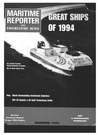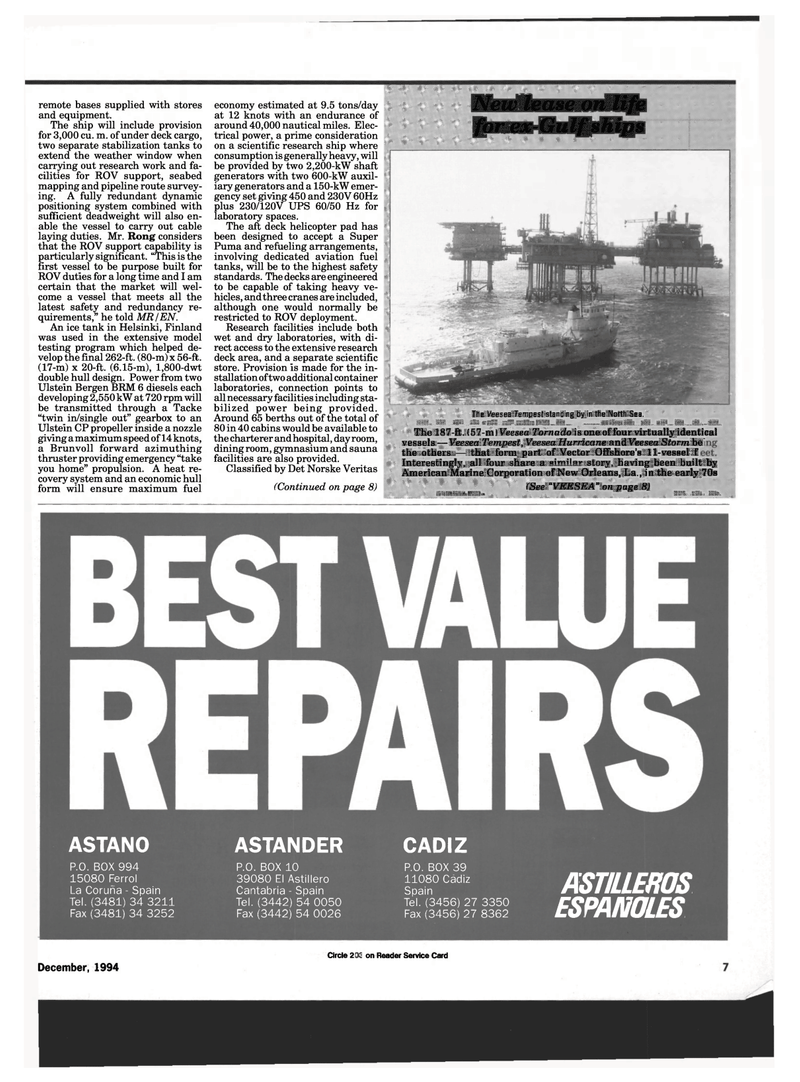
Page 5: of Maritime Reporter Magazine (December 1994)
Read this page in Pdf, Flash or Html5 edition of December 1994 Maritime Reporter Magazine
remote bases supplied with stores and equipment.
The ship will include provision for 3,000 cu. m. of under deck cargo, two separate stabilization tanks to extend the weather window when carrying out research work and fa- cilities for ROV support, seabed mapping and pipeline route survey- ing. A fully redundant dynamic positioning system combined with sufficient deadweight will also en- able the vessel to carry out cable laying duties. Mr. Rong considers that the ROV support capability is particularly significant. "This is the first vessel to be purpose built for
ROV duties for a long time and I am certain that the market will wel- come a vessel that meets all the latest safety and redundancy re- quirements," he told MR/EN.
An ice tank in Helsinki, Finland was used in the extensive model testing program which helped de- velop the final 262-ft. (80-m) x 56-ft. (17-m) x 20-ft. (6.15-m), 1,800-dwt double hull design. Power from two
Ulstein Bergen BRM 6 diesels each developing 2,550 kW at 720 rpm will be transmitted through a Tacke "twin in/single out" gearbox to an
Ulstein CP propeller inside a nozzle giving a maximum speed of 14 knots, a Brunvoll forward azimuthing thruster providing emergency "take you home" propulsion. A heat re- covery system and an economic hull form will ensure maximum fuel economy estimated at 9.5 tons/day at 12 knots with an endurance of around 40,000 nautical miles. Elec- trical power, a prime consideration on a scientific research ship where consumption is generally heavy, will be provided by two 2,200-kW shaft generators with two 600-kW auxil- iary generators and a 150-kW emer- gency set giving 450 and 230V 60Hz plus 230/120V UPS 60/50 Hz for laboratory spaces.
The aft deck helicopter pad has been designed to accept a Super
Puma and refueling arrangements, involving dedicated aviation fuel tanks, will be to the highest safety standards. The decks are engineered to be capable of taking heavy ve- hicles, and three cranes are included, although one would normally be restricted to ROV deployment.
Research facilities include both wet and dry laboratories, with di- rect access to the extensive research deck area, and a separate scientific store. Provision is made for the in- stallation of two additional container laboratories, connection points to all necessary facilities including sta- bilized power being provided.
Around 65 berths out of the total of 80 in 40 cabins would be available to the charterer and hospital, day room, dining room, gymnasium and sauna facilities are also provided.
Classified by Det Norske Veritas (Continued on page 8)
New lease on life for ex-Gulf ships
The Veesea Tempest standing by in the North Sea. 1J|||, ...ill.'...,!|11... ..111:.: :jflh. ... j|l. :, llli .. Jill, ,111, .:: .. Jill .Jill. .llll,,..j||l, .Ml::,. .Ills:,, :J|||,:,
The 187-ft. (57-m) Veesea Tornado is one of four virtually identical vessels —Veesea Tempest, Veesea Hurricane and Veesea Storm b " the others — that form part of Vector Offshore's 11-vessel f
Interestingly, all four share a similar story, having been built by
American Marine Corporation of New Orleans, La., in the early 70s (See "VEESEA" on page 8) lllll i Jll§^: Jlllliw^Jill:;:..sllll:;;... .111!:,:.
ASTANO
P.O. BOX 994 15080 Ferrol
La Coruna - Spain
Tel. (3481) 34 3211
Fax (3481) 34 3252
ASTANDER
P.O. BOX 10 39080 El Astillero
Cantabria - Spain
Tel. (3442) 54 0050
Fax (3442) 54 0026
CADIZ
P.O. BOX 39 11080 Cadiz
Spain
Tel. (3456) 27 3350
Fax (3456) 27 8362
ASTILLEROS ESPANOLES
December, 1994
Circle 272 on Reader Service Card 51

 4
4

 6
6
